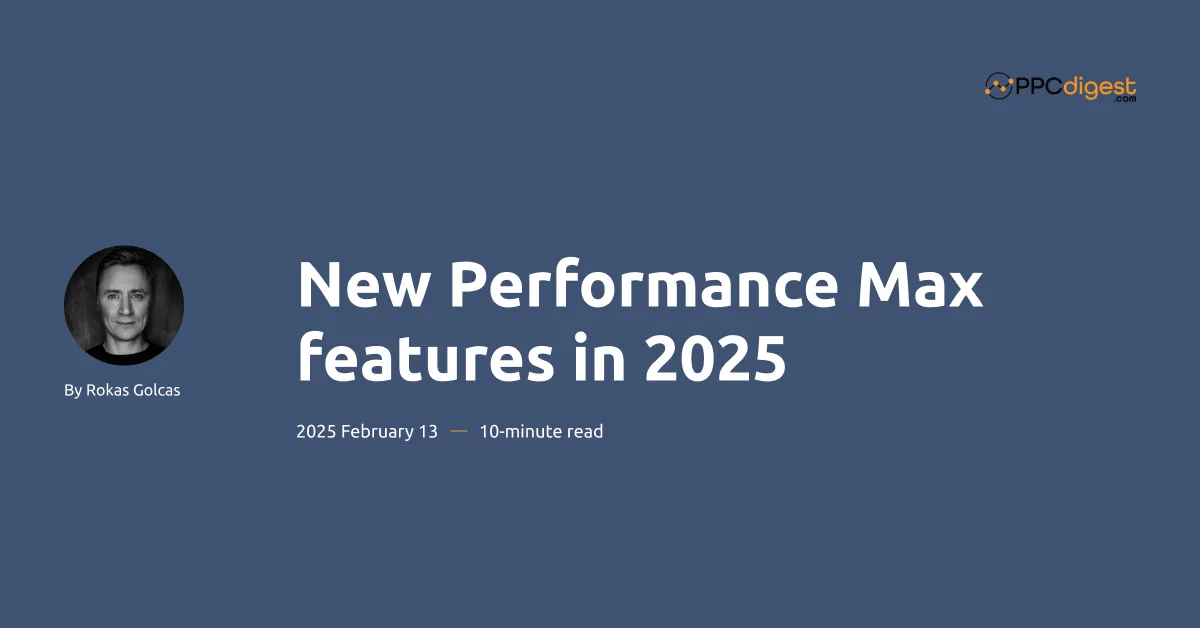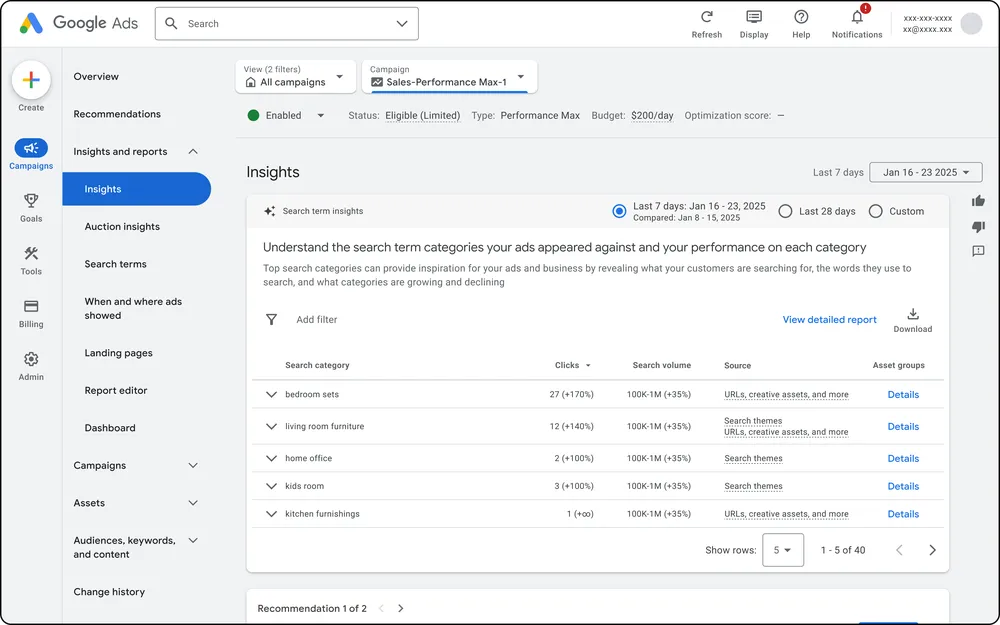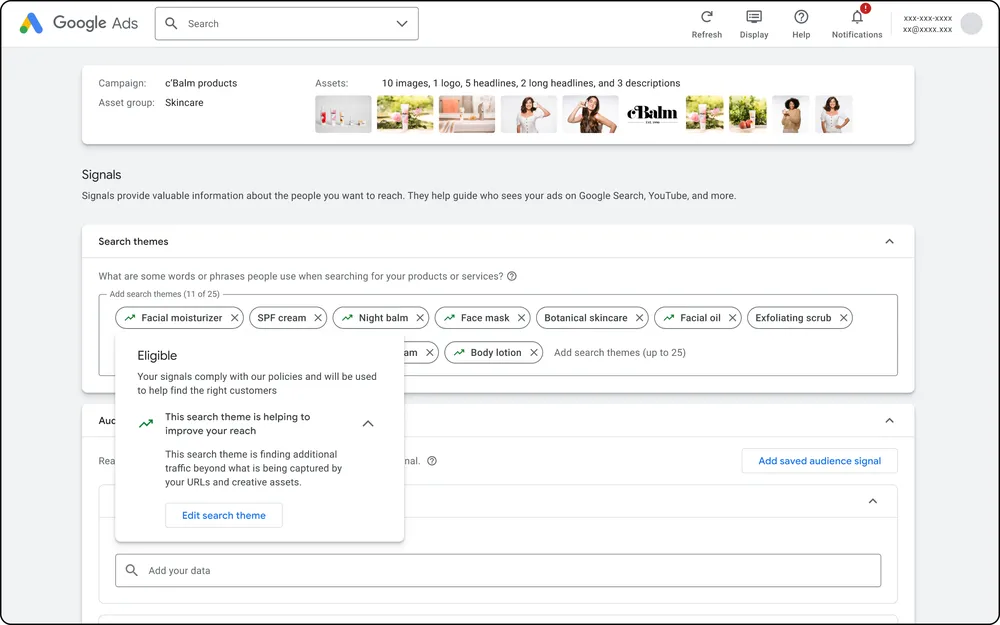
Since Performance Max is probably Google’s favorite campaign type, it’s no surprise that more updates are coming in this year.
The most exciting one to me, and probably many others, is the Campaign’s negative keywords. But let’s explore everything.
Here’s what’s coming in PMax
First, here’s the full list of updates that are coming to your accounts. Some already have them, others might get them in the coming weeks.
- Campaign-level negative keywords rolling out to all advertisers
- New customer acquisition goal with high-value mode
- Brand exclusions for different formats in retailer campaigns with product feeds
- “URL contains” rules for campaigns with product feeds
- Demographic exclusions
- Device targeting
- Search themes usefulness indicator
- Search terms insights source column
- Ability to segment and download asset group performance
Let’s review them.
More control for your PMax campaigns
Campaign-level negative keywords
If you wanted to exclude keywords from PMax, like your brand keywords, for example, you had to fill out the form and let Google rep do it. Not anymore.
Campaign-level negative keywords will let you exclude specific queries to enhance brand suitability and control ad placements. This feature is now rolling out to all advertisers over the next few weeks.
High-value new customers
You can also optimize Performance Max campaigns to acquire high-value new customers with the newly launched customer acquisition goals. Following last year’s beta, the high-value new customer mode is now available to all advertisers. This feature allows you to define your most valuable customers using Customer Match and their estimated long-term value.
Google AI will then leverage this data to identify and prioritize new users with the highest potential lifetime value, ensuring smarter bidding. Additionally, campaign-level reporting now provides insights into how many new customers your campaign is attracting—including those identified as high-value.
Brand exclusions
For retail advertisers using product feeds, brand exclusions are getting more flexible. Previously, brand exclusions applied across both Search and Shopping ads. Now, you’ll have the option to apply them solely to Search text ads while maintaining branded traffic for Shopping ads. This update is particularly useful if you want to keep Shopping ads for brand-related searches but manage Search text ads separately in a different campaign.
URL contains in PMax with product feeds
Additionally, “URL contains” rules, previously available in standard Performance Max campaigns, are expanding to Performance Max campaigns with product feeds. This feature enables you to target traffic based on specific page categories. For example, an athletic apparel retailer could target all website pages containing “shoes” in the URL, allowing for more precise campaign segmentation.
Two exciting new betas are also on the way for Performance Max
Age-based demographic exclusions let you exclude specific age groups, such as 18-24 or 65+, to refine your audience targeting.
Device targeting beta allows you to tailor campaigns to traffic from computers, mobile devices, or tablets, giving you greater control over where your ads appear.
If you’re interested in joining either beta, contact your Google Ads account team or Google Ads support to sign up.
Enhanced Search reporting
Performance Max is getting richer and more detailed reporting this month! Previously, Google introduced search themes in beta, allowing you to specify queries your customers are likely using to find your business. These act as an additive layer on top of Performance Max’s keywordless targeting, which automatically identifies high-performing queries based on your assets, feeds, and landing pages.
Search themes are now officially launching—with significant improvements. A key upgrade is the ability to use search terms insights to determine whether queries are coming from Performance Max’s AI-driven keywordless targeting or from the search themes you’ve provided.
As you know, Search themes don’t act like keywords, they act like signals. Moreover, Google can choose to ignore Search themes. This update will tell you if it was your specified terms or something that Google decided to pick.
New Source Column in Search Terms Insights
A new “source” column in search terms insights lets you see exactly where your queries are originating—giving you greater transparency and control over your campaign’s search performance.

Search Theme Usefulness Indicator
We’re also adding a usefulness indicator next to your search themes, helping you assess their impact. This insight will show whether your search themes are driving incremental traffic beyond what Performance Max would find on its own or if adjustments are needed for better results.

These updates make it easier to fine-tune your search themes and maximize campaign performance with data-driven decisions.
Improved asset group reporting
Google is. expanding asset group reporting with powerful new capabilities! Segmentation for asset group performance is now rolling out across all Performance Max campaigns, allowing you to break down results with greater granularity—including conversions by device, time, and more.
Additionally, asset group performance is now downloadable, making it easier to analyze and integrate your insights into external reports.
Stay tuned for even more Performance Max enhancements in the coming months, including new controls, reporting, and deeper insights.

Blogging gives me a chance to share my extensive experience with Google Ads. I hope you will find my posts useful. I try to write once a week, and you’re welcome to join my newsletter. Or we can connect on LinkedIn.